<<
5-Water-Volume-6-Water-Races
2 Malvern Water Races
2.1 Scheme Summary
Scheme area (within scheme boundary)
| 61,684 ha |
Scheme Coverage (as at 1 Jan 2021)
| Area of Full Charges | |
| Unit Charge (No.) | 337 |
| Irrigators | 3 |
Systems components
| Intakes | 8 (including springs) |
| Main Race | 214.66 km |
| Local Race | 611.58 km
|
| Lateral Race | 63.14 km |
| Other | 5 Aqueducts
9 Tunnels
5 Data logged Flow gauging sites + CPW gauging site |
| Water Source | via River | Waimakariri River, Selwyn River and Springs |
| History | Installation date | Installed progressively from 1885 |
Value ($)
| Replacement Cost | $75,578,521
|
| Depreciated Replacement Cost | $35,500,153
|
Financial
| Annual maintenance cost
% of total water race scheme maintenance
| $765,780/year
36% of total water race scheme maintenance spend
|
Water Take
| Annual average (from Management Plan) | 36.2 million m3 |
| Consented Take | 1,375 Lts/sec |
Sustainability
| Biodiversity | Groundwater recharge and natural habitat |
| Amenity | Urban features |
2.2 Key Issues
The following key issues are associated with the Malvern Water Race system. A list of district wide issues are located in 5Waters Activity Management Plan: Volume 1.
Table 2‑1 Malvern Scheme Issues
| Council are facing a large peak in forecast renewals for large infrastructure including the Kowai and Waimakariri tunnels | Plan to undertake condition assessments and budget for major repairs of these assets considering the future of these schemes. Consider the closure of inefficient infrastructure |
| Impacts of CPW on the future of the water race scheme. | Council will continue to work with CPW to best service the needs of the rate payers. |
| Due to fluctuating river levels, resource consent conditions are not always met with manually operated intake gates. | Council will consider opportunities to budget for automation of the intakes where cost effective to improve consent compliance and reduce operational costs. |
| Flow monitoring required for season springs which is impractical, costly and there is no alternative location for this water. | Council has applied for a consent variation to remove the need to monitor these seasonal springs which have traditionally discharged to the race network to manage flooding. |
| Operating race for biodiversity values will add financial pressure. | An alternative rating structure is proposed which takes into account benefits of the race network other than stock water. The alternative rating structure is one of the matters included in the 2018-28 consultation document. |
2.3 Overview & History
The Malvern scheme serves the plains areas between the Waimakariri River on the north side and Selwyn River and from Springfield Township and Glentunnel to the boundary of the Paparua scheme and totals some 61,684 hectares.
This scheme requires a very high level of operator “hands on" maintenance to ensure a good and adequate supply of water to consumers. This is due to diverse water sources (Kowai, Waimakariri, Selwyn Rivers) and a number of springs.
Natural events impacting the water race network
Following the September 2010 and February 2011 earthquakes there was damage to the Lower Kowai 950m brick barrel tunnel. A detailed condition assessment was undertaken and repair work was scheduled and completed in 2012.
Significant damage occurred to the water races as a result of the wind event in September 2013. Repairs were carried out as a result.
Sinkholes are known to form over the second “Bull's" tunnel, investigations are ongoing.
CPW shared water use agreement.
The Council's Long Term Plan 2015-2025 identifies one of the major projects to be the Council's commitment to 'work with Central Plains Water to develop a concept for converting the Kowai River sourced water race network (part of the Malvern Water Race Scheme) into a combined water race and irrigation network. This concept will then be used for further consultation with the community.'
The Council entered into agreement with CPW on 16th December 2016. The philosophy of the Agreement is to achieve a mutually beneficial cost neutral position. While the Scheme will benefit from a potential 200l/s of reliable water for irrigation, the added value the Scheme will provide to the community includes providing a robust and secure long term piped water supply to both the Sheffield and Springfield drinking water treatment stations. Which, from a water quality perspective enables the Council to avoid use of shallow groundwater during periods of high turbidity in adjoining rivers, or as required for capacity augmentation; and providing the necessary water quantity to support future township expansion. In addition, a piped stock water supply to shareholders and non-shareholders will ensure this historical network is upgraded to a high quality, efficient utility.
Kowai Water Race Tunnel
During the 2015/16 and 2017/18 summers, Council has trailed running the Malvern Water Race scheme without the lower Kowai River intake. This trial has been successful, but has resulted in longer periods where the Waimakariri River intake has been in use and increased maintenance requirements of the Upper Kowai Intake.

Figure 2‑2 Scheme Schematic
2.4 Resource Consents
The Malvern water race scheme has a number of resource consents. Table 2‑2 shows that water takes permitted by the resource consents at the intakes, and Table 2‑3 details the resource consents for this scheme.
Table 2‑2 Allowable Take
| Kowai - Lower | Nil | 300 |
| Waimakariri River Gorge | 630 | 700 |
| Waimakariri River spring | 60 | 60 |
| Glentunnel | 250 | 250 |
|
Total | 1,375 | 2,210 |
Table 2‑3 Resource Consents
| CRC012002 | To disturb the beds and banks of the Kowai River, Waimakariri River, Selwyn River, Bishops Gully Creek, Skurrs Spring, Springfield Creek and Blacks Creek for the purpose of maintaining intake structures and maintaining diversion braids. | Stockwater Race Network | 31/01/2008 | 05/11/2028 | Issued - Active |
| CRC012004 | To discharge water and water containing contaminates into land and/or water from the stockwater scheme at a number of points into waterways, drains and soak pits. | Stockwater Race Network | 31/01/2008 | 05/11/2028 | Issued - Active |
| CRC160916 | To take and use surface water | Stockwater Race Network | 16/01/2015 | 05/11/2025 | Issued – Active |
CRC201738
| Global Consent - To discharge contaminants into water and onto land in circumstances where they may enter surface water
| Global Consent (Spraying)
| 25/01/2021
| 25/01/2036
| Issued - Active
|
CRC212849
| Global Consent - To discharge contaminants to air
| Global Consent (Spraying)
| 25/01/2021
| 25/01/2036
| Issued - Active
|
| CRC155937 | To divert, take and use water. | Springfield Township, Springfield | 28/08/15 | 5/11/2028 | Issued -Active |
2.5 Water Quality
Under consent CRC012004 Council were required to undertake water quality sampling. A summary of these results can be found in Table 2‑4 below.
Table 2‑4 Sampling Results
| 1 | Waimakariri Gorge Intake | 21/04/2010 | 101 | 24 | 2.6 | <1.0 | <0.002 | <0.02 |
| 2 | Upper Kowai Intake | 8/09/2009 | 84 | none detected | 16.2 | 1.0 | 0.0052 | <0.02 |
| 3 | Lower Kowai Intake | 22/08/2009 | 120 | 7 | 58.4 | <1.0 | <0.002 | <0.02 |
| 4 | Bishop Creek Booster | 20/10/2009 | 2419 | 613 | 5.0 | <1.0 | 0.0023 | <0.02 |
| 6 | Springfield Creek booster No 1 | 1/12/2009 | >2419 | 326 | 6.1 | <1.0
| <0.002 | <0.02 |
| 9 | Glentunnel Intake | 3/03/2010 | 1120 | 74 | <1.1 | <1.0 | <0.002 | <0.02 |
| 10 | McCurdys Road | 31/05/2010 | 1733 | 161 | 11.1 | <1.0 | 0.008 | 0.02 |
| 11 | Bluff Road | 11/01/2010 | >2419 | 272 | 5.5 | <1.0 | <0.002 | <0.02 |
2.6 Scheme Assets
2.6.1 Intake
The Malvern Water Race System has four main intakes:
- The Waimakariri River
- The Upper Kowai River
- The Lower Kowai River
- The Selwyn River
The main source of water for the Malvern scheme in the winter months is the Kowai River. There are two intakes sited on the Kowai River, these intakes serve about 80% of the Malvern scheme during the winter months and early spring months. The Glentunnel intake supplies the other 20%.
Waimakariri Intake - The Waimakariri intake consists of a small lead-in channel that extends from the intake control gates up the riverbed for approximately 50 to 60 metres around the bottom of the cliff. The length depends on the location of the river braids. This is followed by a 95-metre section of rock tunnel. A 300-metre length of deep excavated main race leads away from the tunnel outlet. The intake structure is set back into the riverbed rock terrace. On the front of this structure there are two vertical sluice gates set into a wooden frame. The 95-metre rock tunnel leads directly away from the control gates and is subject to filling with river material if the gates are not closed before major flooding.
Skurrs Spring - The site is 1.5 km downstream of the Waimakariri intake. It discharges into the main race at a rate of 60 litres per second and this is a constant flow all year round. Ten litres per second is diverted back to the Waimakariri River.
Upper Kowai Intake - The intake structure is sited on the southern bank of the Kowai River and constructed into the rock face of the riverbank. The structure is constructed of concrete walls and the floor is bedded into the rock face, a steel grill, two wooden sluice control gates, and 80 metres downstream of the intake is a shingle removal structure. This section of river has a steep grade and a large grill is used to protect the intake from large rocks and gravel which move down the river when in flood.
If the rain is very heavy and run-off from the surrounding hills enters the main race an emergency discharge spill point located 1 km downstream of the intake would be used. It is used to prevent major flooding downstream in the Springfield Township. The water from this spill point discharges back into the Kowai River.
Downstream 1.4km of the intake is a large aqueduct with a butylene liner that carries water across the gully. This must be inspected daily for debris. The flow monitoring point is also sited at this location and flow must be recorded at this point daily.
Lower Kowai Intake - The intake consists of a small dam, gratings, control gates, a section of open race with a concrete river protection floodwall, a small 30 metre tunnel with a floodgate at its entrance. There is a second section of open race leading to a large 950 metre long brick barrel tunnel fitted with floodgates at the entrance.
A small gravel weir is constructed in the riverbed at the Lower Intake to divert water to ensure the intake retains sufficient flows.
Directly behind the intake control gate, a 30 metre long concrete floodwall leads down the main race from the intake to protect the main race from moderate to high flooding. Water race flow is monitored at this point.
The Lower Kowai Intake is fed into the Malvern Scheme through two tunnels and joins the upper Kowai race about 1km downstream of the SH73 Bridge becoming one main race.
As flows in the river drop, the intake gate has to be adjusted to keep race flows up to the required scheme demand. This demand will change from low demand in summer period to high demand in the winter months.
Glentunnel Intake - The Glentunnel Intake consists of one sluice control gate, and a medium size gravel and boulder weir spanning across the Selwyn riverbed. Some 450 metres downstream from the intake in the main race is a floodgate and spill point channel to divert flood water back to the Selwyn River.
The intake is a simple sluice gate set on the western bank of the Selwyn River. The main race feeds away from the gate through the Hororata Golf Course and on through the Coalgate Township. This intake supplies the area between the Hawkins, Selwyn and Waireka Rivers as well as joining the Kowai system near Bangor to supply the Greendale area of the scheme.
The height of the weir is 1.5m, the width is 5m and the length is 50m. A section of the dam is constructed to allow natural flows to occur and allowing for fish passage. The dam is constructed with a “weak section" so this section can be “overtopped" or fail in floods. This approach avoids the need to reconstruct the entire dam after flooding.
2.6.2 Silt Ponds
There are no operational silt ponds within the Malvern Water Race Scheme. Silt is removed through the annual cleaning programme. Historically, there was a silt pond down stream from the Waimak Intake.
2.6.3 Control Structures
Divides are on the main races below the main intake control gates. The divides are a mixture of single or multiple control gates are sited where the main race flow requires splitting into equal or different flows. Each split race then goes in to serve a different area of the scheme.
2.6.4 Monitoring Points
The monitoring sites on the Malvern Water Race System are sited at approximately 1.5 km downstream of the Waimakariri Intake tunnel, Upper and Lower Kowai Intakes on the Kowai above the SH73 bridge, Glentunnel Intake at the golf course on the Selwyn River, and Selwyn intake Bridge Street south of Coalgate Township off the Selwyn River. Skurrs Spring is also monitored.
The intake flows are measured and are reported upon to comply with resource consent take conditions.
There is no monitoring of the race flows that cross the boundary from the Malvern water race system to the Paparua scheme but generally these are very small flows (< 5 l/s).
2.6.5 Emergency Discharge Points
Emergency and Buffer Discharge points on main races, and on some minor races, are required to dump surplus water from the race system. This normally occurs when water from heavy rain has entered the race system causing flooding. This water is required to be quickly removed from the system to prevent flooding at downstream flooding or when dewatering is required to permit work on a section of race.
These Emergency Discharge and Buffer Points are located at:
- Upper Kowai Main race 300 metres above SH73 Kowai Bridge
- Odges Divide SH73 into Bishops Creek exiting into the Hawkins River
- Kirwee in Railway Reserve 200 metres below Township into a large soak hole
- Glentunnel below the intake 450 metres at the bottom end of the golf course back into the Selwyn River
- Waiwaniwaniwa River at west end of race fluming that crosses the river discharges into Waianiwaniwa River
- Hewitt Spill Point
- West end of Blacks Creek siphon discharges into Blacks Creek
- Waimakariri terrace race 6 emergency spill weirs back to the Waimakariri River
- Judd's Siphon Waimakariri race back to the Waimakariri River
- Old West Coast Road and Redmond's Road small race on north side of road discharge point into Gully back to Waimakariri River
- Old West Coast Road and Pitt's Road small race on north side of road discharge into Gully back to Waimakariri River
- Old West Coast Road and Cooks Road small race on north side of road discharge into drain back to Waimakariri River
2.6.6 Soak Holes
Soak holes allow excess water to be taken from the intake to buffer additional usage such as high water use and at the end of races. A maximum of 10 l/sec per soak hole is permitted. There are 71 soak holes (including privately owned) in the Malvern scheme.
2.6.7 Pipe Summary
A summary of material and diameter for pipes (culverts and aquaducts), where known, is shown below in Figure 2‑3 and Figure 2‑4.
Figure
2‑3 Pipe Material - Malvern
Figure 2‑4 Pipe Diameter – Malvern
2.7 Operational Management
Presently the scheme is operated from two intakes during the winter months being the Upper Kowai River Intake and the Selwyn River Glentunnel Intake. In the spring, summer and autumn months the scheme is operated with up to four intakes, the Waimakariri Gorge, Upper and Lower Kowai and the Glentunnel Intake.
The Malvern Scheme is divided and operated into two sections. There are two operators - Eastern operator who covers the area east and below Darfield bordering the Paparua scheme and the Western operator covers the area west and above Darfield to the foothills.
The Western operator checks the main intake gates, cleans intake grills, records the river flows at the flow monitoring sites, and when required adjusts the intake gates. It may also be necessary to carry out river diversion works to divert the flows to service the scheme. When any works are carried out within the riverbed the operator must notify ECAN and Selwyn District Council using the River Works Notification form.
The Western Operator may contact the Eastern Operator to ascertain flow requirements in the eastern area.
Adjustments can then be made at either the main intake or other major divides located at Odges, Waddington Main Divide Gates, Bulls Race on Waimakariri River Terrace and the grills located at each siphon, piped section and tunnel over this section of race, Tramway Road and the Kimberley Road main divides, Old West Coast Road (Bulls Race) and SH73 Waddington.
The Eastern Operator firstly inspects the main divides at Kirwee and Charing Cross. From information gained from checking these races the operator contacts the Western Operator and requests more or less water for the lower half of the scheme.
2.8 Irrigation
The Terrace Water Group had an agreement with Council to transport CPW consented water from the Waimakariri River via Council's intake and main race. This agreement ended December 2017 once CPW water became available
The Council entered into agreement with CPW on 16th December 2016 to share water resources in the Sheffield area. The philosophy of the Agreement is to achieve a mutually beneficial cost neutral position. The CPW Scheme will benefit from a potential 200l/s of reliable water for irrigation and Council will receive finantual and water security benefits.
2.9 Environmental Management
2.9.1 Water Quality Issues
Water quality in races is largely affected by runoff and stock activity in races. Runoff containing fertiliser and organic nutrients is difficult to manage. Stock activity (especially cattle, horses and deer) can affect water quality by increasing sedimentation from bank erosion and disturbance of the bottom of the race channel. Direct defecation and surface runoff can also add to elevated faecal coliform levels.
Improved management of the water race network will need to address stock movement in races. Maintenance contractors and users need to be aware of the effect of operation and maintenance activities on water race quality.
2.9.2 Management Approach
The Council will use a combination of the following to address water quality issues:
- Watering bays are being promoted for water races that serve all stock farming properties (excluding sheep). This will allow limited and controlled access to races for stock drinking purposes. The remaining length of races to be fenced off/hot wired so that animals only have access to the race for drinking purposes. This is 'best practice' for managing stock access to races
- The Council will provide guidance to race users on design/layout of watering bays
- Maintenance contractors will ensure that subcontractors use clean and sound machinery when working in riverbeds
- Maintenance Contractors will be required to monitor and minimise discharge of surplus water from the race network
2.9.3 Demand Management
Environment Canterbury as the consenting authority are requiring demand management practices to be implemented as part of new or reviewed consent conditions. This is due to water allocations in most areas of the district being assumed as fully committed.
Selwyn District Council has integrated demand management into the existing Water Race Management Plan.
An Efficiency Audit of the Malvern Scheme dated June 2010 indicated potential improvements to the Water Race scheme.
Table 2‑5 Efficiency Audit Improvement
| Reducing Infiltration or leakage | Most of the obvious leakage areas have been rectified and any new ones are fixed once they become apparent | Without committing to large scale lining of channels with clay, concrete or bentonite, it is unlikely that the chronic infiltration losses can be substantially reduced with current technology Suggested Action: Continue the development of a leakage measurement system and use it to obtain more accurate data about infiltration losses |
| Race rationalisation | There are races that could be decommissioned as they are either not required or could be replaced with short pipe feeds from adjoining races | SDC policy W107 allows the race network to be rationalised from the extremities of the Water Race |
| Control Improvements | Installation of additional automated control and monitoring points | Suggested Action: Investigate the installation of monitoring stations with automated/remote controls at key points within the system |
| Management Improvements | Most of the easy gains in scheme operation have been made. The Water Race management plan provides an improved framework for managing the schemes | Suggested Action: Fully implement the Water Race Management Plan as soon as possible |
2.10 Photos of Main Assets
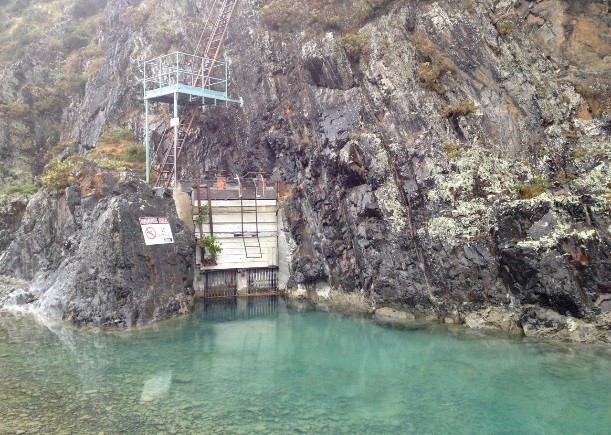
Photo 1: Waimakariri River Intake
|
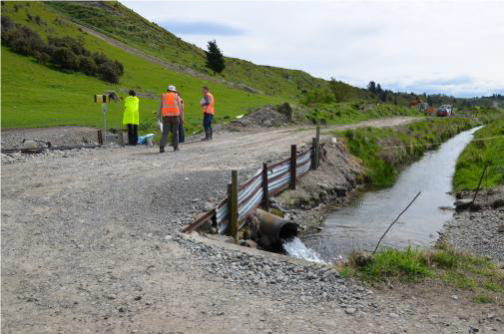
Photo 2: Skurrs Spring
|
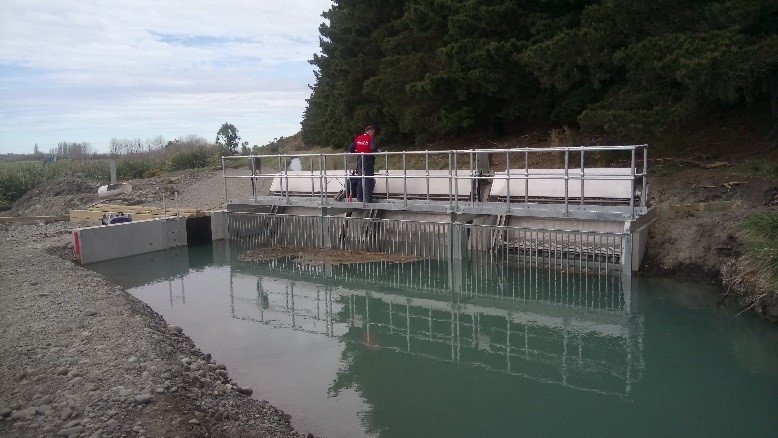
Photo 3: Waimakariri Fish Screen
| 
Photo 4: Upper Kowai Intake
|

Photo 5: Upper Kowai Fish Screen
| 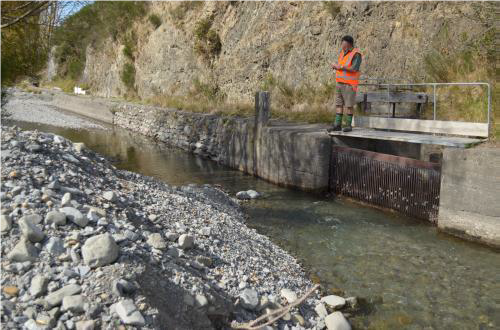
Photo 6: Lower Kowai Intake
|

Photo 7: Glentunnel Intake Weir
| 
Photo 9: Glentunnel Intake
|
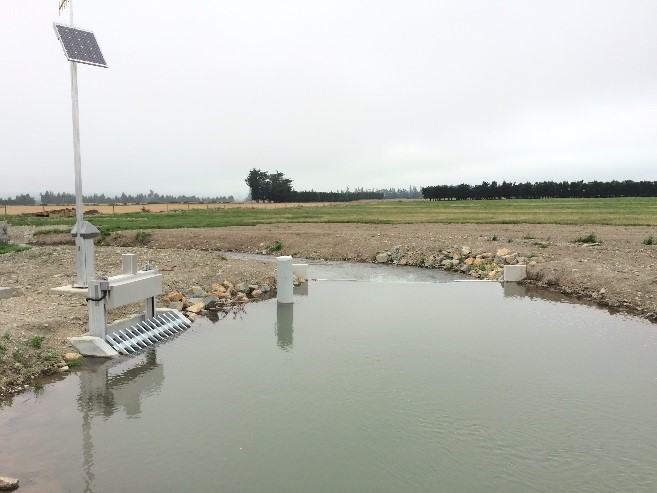
Photo 8: CPW off take from Water Race Network |
2.11 Risk Assessment
A risk assessment has been undertaken for the Malvern scheme. The key output from the risk assessment is the identification of any extreme and high risks which need to mitigated. In order to mitigate these risks they have been included and budgeted for in the projects within this LTP. Table 2‑6 details the risk priority rating, Table 2‑7 outlines the risks and the list of key projects is found in Table 2‑12.
Table 2‑6 Risk Priority Rating
| > 50 | Extreme
| Awareness of the event to be reported to Council. Urgent action to eliminate / mitigate / manage the risk. Document risk and action in the AMP. |
| 35-50 | Very High | Risk to be eliminated / mitigated / managed through normal business planning processes with responsibility assigned. |
| 14-35 | High | Manage risk using routine procedures. |
| 3.5-14 | Moderate | Monitor the risk. |
| < 3.5 | Low | Awareness of the event to be reported to Council. Immediate action required to eliminate / mitigate / manage the risk. Document risk and action in the AMP. |
Table 2‑7 Risks - Malvern
| Collapse of old tunnels Kowai | Condition inspection of water race tunnels | 2014 | 10 | 3.5 | 3.5 |
| Public Health and Safety risks at intakes | Health and Safety improvements | 2014 | 10 | 10 | 10 |
| Sink holes are developing | Develop standard soak hole repair procedures | 2014 | 9 | 9 | 9 |
| Siphons are a risk | Condition inspection of water race siphons | 2014 | 12 | 12 | 10 |
| Non-consented activities | Renewal of consents | 2014 | 27 | 27 | 6 |
| Collapse of old tunnels Waimak | Tunnel repairs | 2017 | | 20 | 10 |
The list of district wide risks can be found in 5Waters Activity Management Plan: Volume 1.
2.12 Asset Valuation Details
The total replacement value of assets within the Malvern Scheme is $75,578,521 with further details in Table 2‑8 below.
Table 2‑8 Replacement Value, Malvern
Plant and Equipment
| $98,039
|
Water Race Reticulation
| Channel | $74,235,074
|
| Divide | $530,324
|
| Gate | $144,107
|
| Inlet-Outlet-Point | $394,518
|
| Instruments | $12,360
|
| Structure | $164,099
|
Channels are broken down into open channels: Culverts, Lateral, Locals and Mains and well as closed channels: tunnels, siphons, culverts and aqueducts.
2.13 Renewals
The renewal profile has been taken from the 2019 5 Waters Valuation. A graph showing the renewals for this scheme are shown by Figure 2‑5 below. The major asset groups requiring renewal is are tunnels, syphons and culverts.
The open race channels are taken as having infinite lives (renewal by maintenance) and therefore renewals are not budgeted for these assets types.
Figure 2‑5 Malvern Water Race Renewal Profile
There are many aging structures within the water race network these include gates, intake structures, tunnels, siphons, aqueducts and culverts. These assets are near the end of their life and will require increased funding moving into the future.
2.14 Critical Assets
The criticality model for Malvern has been updated for the 2021 AcMP. The methodology of the criticality model can be found in 5Waters Activity Management Plan: Volume 1 and it provides details of how the criticality has been calculated for the reticulation assets. Table 2‑9 and Figure 2‑6 below show the level of criticality for all of the assets within this scheme that have a recorded known length.
Table 2‑9 Length of Assets per Criticality Level
5
| Low | 666,843
|
4
| Medium-Low | 162,109
|
3
| Medium | 13,622
|
2
| Medium-High | 7,227
|
1
| High | 174
|
2.15 Asset Condition
The asset condition model was run for Malvern in 2021. The methodology of the model can be found in 5Waters Activity Management Plan: Volume 1 and it provides details of how the model has been calculated for the reticulation assets (particularly pipes). Figure 2‑7 below shows the level of asset condition for all of the assets within this scheme that have a recorded known condition.
Table 2‑10 provides a description of the condition rating used within the condition model.
Table 2‑10 Asset Condition Grading
| 1.0 | Excellent |
| 2.0 | Good |
| 3.0 | Moderate |
| 4.0 | Poor |
| 5.0+ | Fail |
2.16 Funding Program
The 10 year budgets are shown by Table 2‑11. Budgets are split into expenditure, renewals, projects and capital projects. Expenditure and renewals have been reported on a district-wide basis in Volume 1.
All figures are ($) not adjusted for CPI “inflation". They are calculated on historical data, and population growth where relevant.
Table 2‑11 Budget Summary
| 2021/2022 | $40,000
| -
|
2022/2023
| -
| -
|
| 2023/2024 | $15,000
| $60,000
|
| 2024/2025 | -
| $10,000
|
| 2025/2026 | -
| -
|
| 2026/2027 | -
| -
|
| 2027/2028 | -
| - |
2028/2029
| -
| $200,000
|
2029/2030
| -
| -
|
2031/2032
| -
| -
|
| Total | $55,000
| $270,000
|
An explanation of the categories within the budgets are as follows below:
-
Expenditure consists of operation and maintenance costs;
-
Renewals are replacement of assets which are nearing or exceeded their useful life;
-
Projects are investigations, decisions and planning activities which exclude capital works; and
-
Capital projects are activities involving physical works.
Table 2-12 Key Projects
Projects &
Capital Projects
| -
| Waimakariri Tunnel intake automation design & construction
| $20,000
| -
| -
| $200,000
| 100% LoS
|
Capital Projects
| -
| Springfield gravel trap
| -
| -
| $10,000
| -
| 100% LoS
|
Capital Projects
| -
| Upgrade Glentunnel tip-out and add SCADA
| -
| -
| $30,000
| -
| 100% LoS
|
Capital Projects
| -
| Access road to upper Kowai
| -
| -
| -
| $10,000
| 100% LoS
|
Capital Projects
| -
| SCADA at Coalgate, Darfield
| -
| -
| $20,000
| -
| 100% LoS
|
Projects
| -
| Investigate closing Waimak and pump water up
| $10,000
| -
| -
| -
| 100% LoS |
Projects
| -
| Bulls access to water race through private property
| -
| -
| $10,000
| -
| 100% LoS
|
* Where LoS refers to Level of Service and G refers to Growth
The list of district wide projects can be found in 5Waters Activity Management Plan: Volume 1.
Discussion on Projects
Projects have been determined based on their:
- Relevance to the scheme
- Requirement to be completed under legislation
- Ability to bring the scheme up to or maintain the Level of Service required under council's Asset Management Policy.
Many projects are jointly funded by more than one scheme and activity. Each scheme pays a pro-rata share only, equivalent to the number of connections.
Discussion on Capital and Projects
Where relevant, Capital (Levels of Service) and Capital (Growth) projects have been included in the scheme financial details.
Levels of Service Projects and growth splits have been provided to ensure the costs of population driven works are clear.
<<
5-Water-Volume-6-Water-Races

